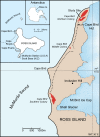Mutation and evolutionary rates in adélie penguins from the antarctic
- PMID: 18833304
- PMCID: PMC2546446
- DOI: 10.1371/journal.pgen.1000209
Mutation and evolutionary rates in adélie penguins from the antarctic
Abstract
Precise estimations of molecular rates are fundamental to our understanding of the processes of evolution. In principle, mutation and evolutionary rates for neutral regions of the same species are expected to be equal. However, a number of recent studies have shown that mutation rates estimated from pedigree material are much faster than evolutionary rates measured over longer time periods. To resolve this apparent contradiction, we have examined the hypervariable region (HVR I) of the mitochondrial genome using families of Adélie penguins (Pygoscelis adeliae) from the Antarctic. We sequenced 344 bps of the HVR I from penguins comprising 508 families with 915 chicks, together with both their parents. All of the 62 germline heteroplasmies that we detected in mothers were also detected in their offspring, consistent with maternal inheritance. These data give an estimated mutation rate (micro) of 0.55 mutations/site/Myrs (HPD 95% confidence interval of 0.29-0.88 mutations/site/Myrs) after accounting for the persistence of these heteroplasmies and the sensitivity of current detection methods. In comparison, the rate of evolution (k) of the same HVR I region, determined using DNA sequences from 162 known age sub-fossil bones spanning a 37,000-year period, was 0.86 substitutions/site/Myrs (HPD 95% confidence interval of 0.53 and 1.17). Importantly, the latter rate is not statistically different from our estimate of the mutation rate. These results are in contrast to the view that molecular rates are time dependent.
Conflict of interest statement
The authors have declared that no competing interests exist.
Figures




Similar articles
-
High mitogenomic evolutionary rates and time dependency.Trends Genet. 2009 Nov;25(11):482-6. doi: 10.1016/j.tig.2009.09.005. Epub 2009 Oct 14. Trends Genet. 2009. PMID: 19836098
-
Proliferation of East Antarctic Adélie penguins in response to historical deglaciation.BMC Evol Biol. 2015 Nov 18;15:236. doi: 10.1186/s12862-015-0502-2. BMC Evol Biol. 2015. PMID: 26577544 Free PMC article.
-
Rates of evolution in ancient DNA from Adélie penguins.Science. 2002 Mar 22;295(5563):2270-3. doi: 10.1126/science.1068105. Science. 2002. PMID: 11910113
-
Ancient population genomics and the study of evolution.Philos Trans R Soc Lond B Biol Sci. 2015 Jan 19;370(1660):20130381. doi: 10.1098/rstb.2013.0381. Philos Trans R Soc Lond B Biol Sci. 2015. PMID: 25487332 Free PMC article. Review.
-
Adélie penguins and temperature changes in Antarctica: a long-term view.Integr Zool. 2012 Jun;7(2):113-20. doi: 10.1111/j.1749-4877.2012.00288.x. Integr Zool. 2012. PMID: 22691195 Review.
Cited by
-
The strength and timing of the mitochondrial bottleneck in salmon suggests a conserved mechanism in vertebrates.PLoS One. 2011;6(5):e20522. doi: 10.1371/journal.pone.0020522. Epub 2011 May 31. PLoS One. 2011. PMID: 21655224 Free PMC article.
-
Mitochondrial DNA mutations in human oocytes undergo frequency-dependent selection but do not increase with age.bioRxiv [Preprint]. 2024 Dec 12:2024.12.09.627454. doi: 10.1101/2024.12.09.627454. bioRxiv. 2024. PMID: 39713397 Free PMC article. Preprint.
-
PHFinder: assisted detection of point heteroplasmy in Sanger sequencing chromatograms.PeerJ. 2023 Sep 19;11:e16028. doi: 10.7717/peerj.16028. eCollection 2023. PeerJ. 2023. PMID: 37744223 Free PMC article.
-
Evaluating the impact of post-mortem damage in ancient DNA: a theoretical approach.J Mol Evol. 2011 Oct;73(3-4):244-55. doi: 10.1007/s00239-011-9474-z. Epub 2011 Nov 20. J Mol Evol. 2011. PMID: 22101653
-
Improved calibration of the human mitochondrial clock using ancient genomes.Mol Biol Evol. 2014 Oct;31(10):2780-92. doi: 10.1093/molbev/msu222. Epub 2014 Aug 5. Mol Biol Evol. 2014. PMID: 25100861 Free PMC article.
References
-
- King JL, Jukes TH. Non-Darwinian Evolution. Science. 1969;164:788–798. - PubMed
-
- Penny D. Relativity for molecular clocks. Nature. 2005;436:183–184. - PubMed
-
- Ho SYW, Phillips MJ, Cooper A, Drummond AJ. Time dependency of molecular rate estimates and systematic overestimation of recent divergence times. Mol Biol Evol. 2005;22:1561–1568. - PubMed
-
- Ho SYW, Larson G. Molecular clocks: when times are a-changin’. Trends in Genetics. 2006;22:79–83. - PubMed
-
- Parsons TJ, Muniec DS, Sullivan K, Woodyatt N, Alliston-Greiner R, et al. A high observed substitution rate in the human mitochondrial DNA control region. Nat Genet. 1997;15:363–368. - PubMed
Publication types
MeSH terms
Substances
LinkOut - more resources
Full Text Sources

